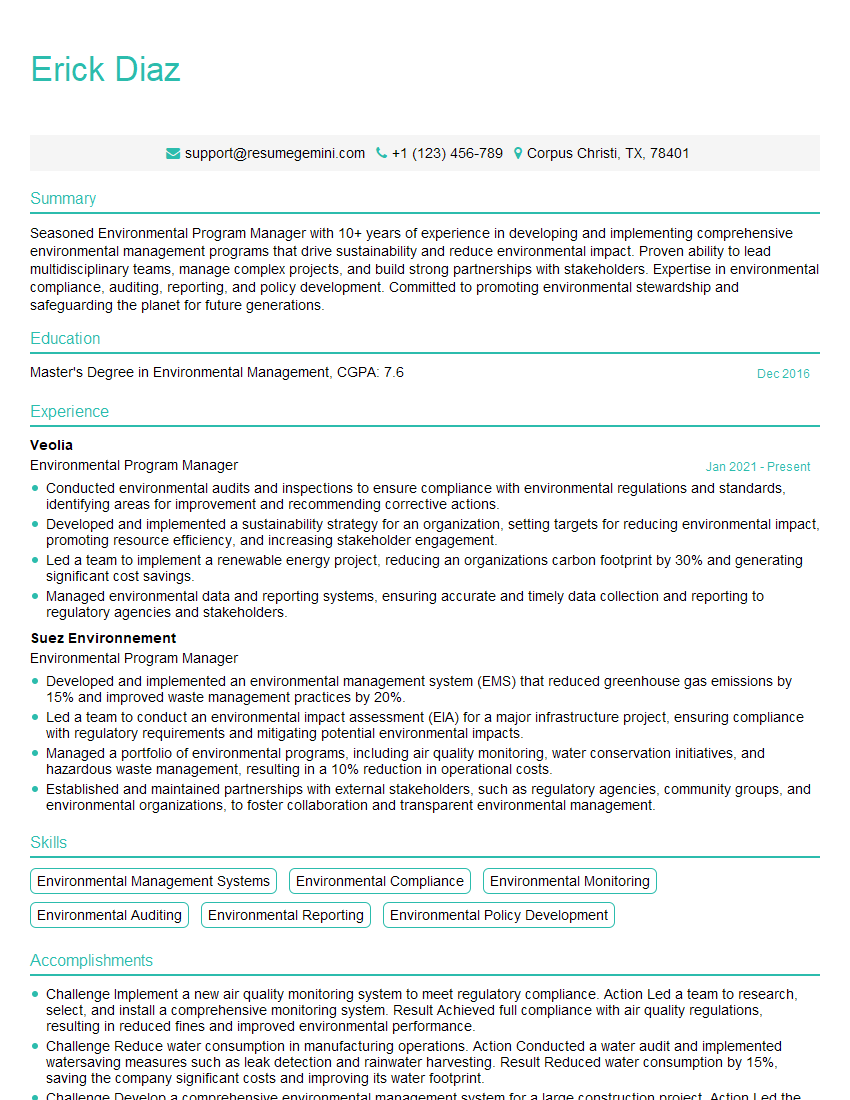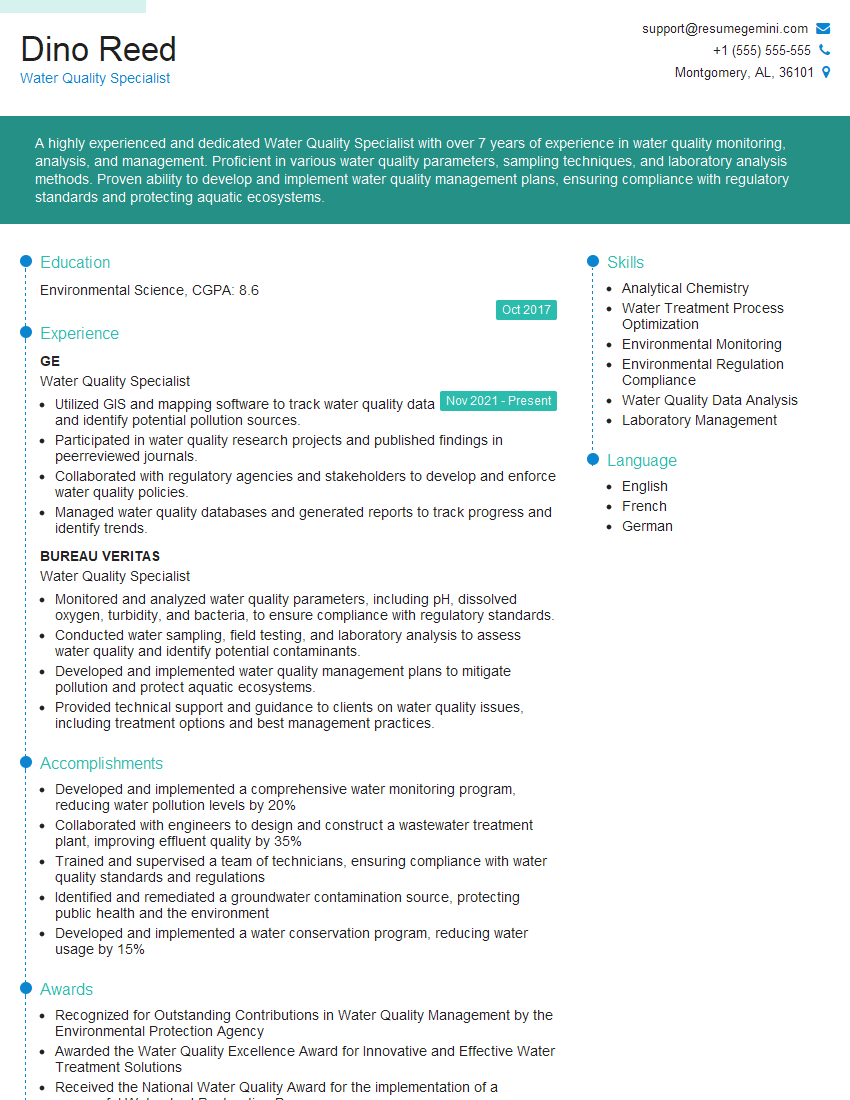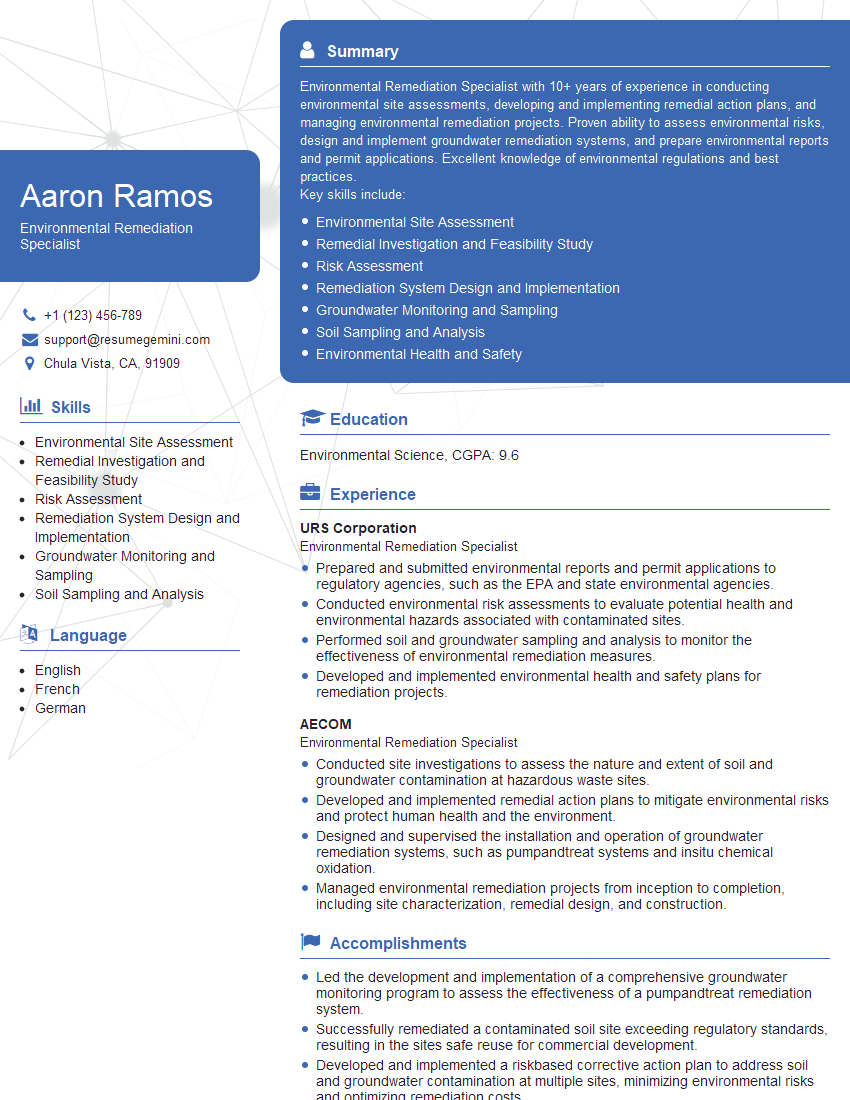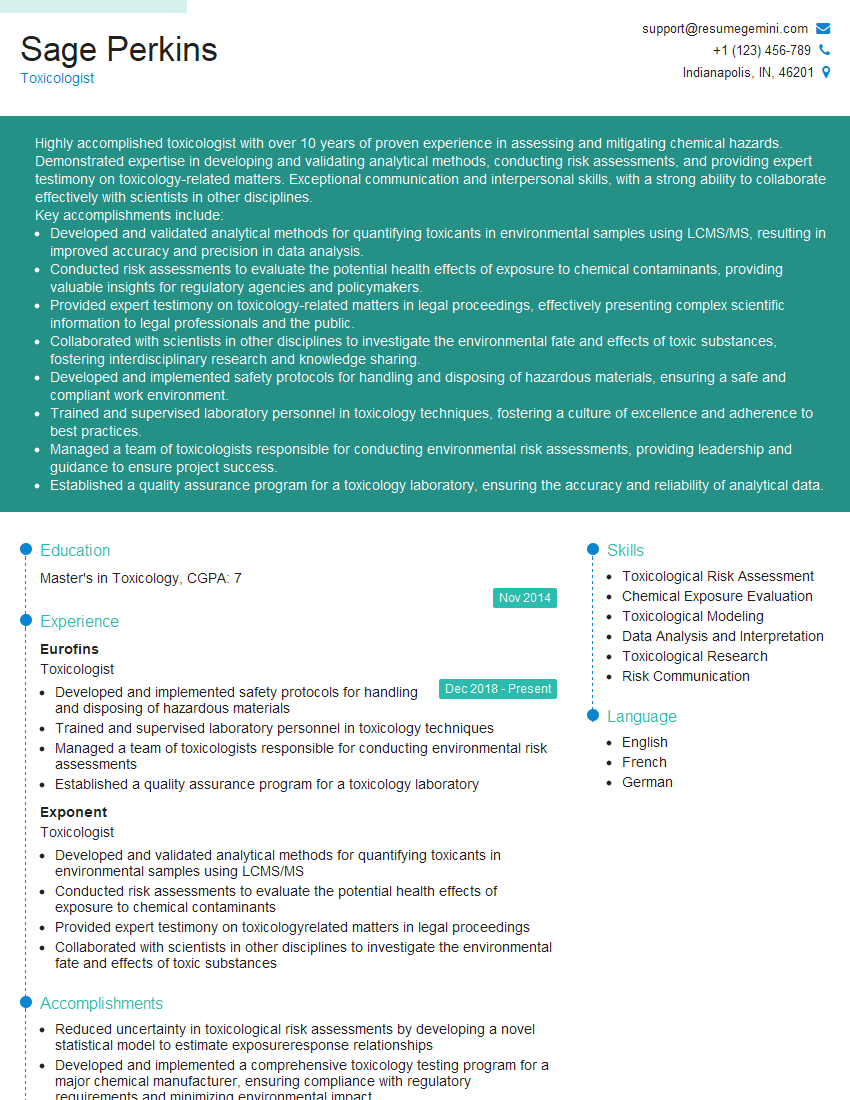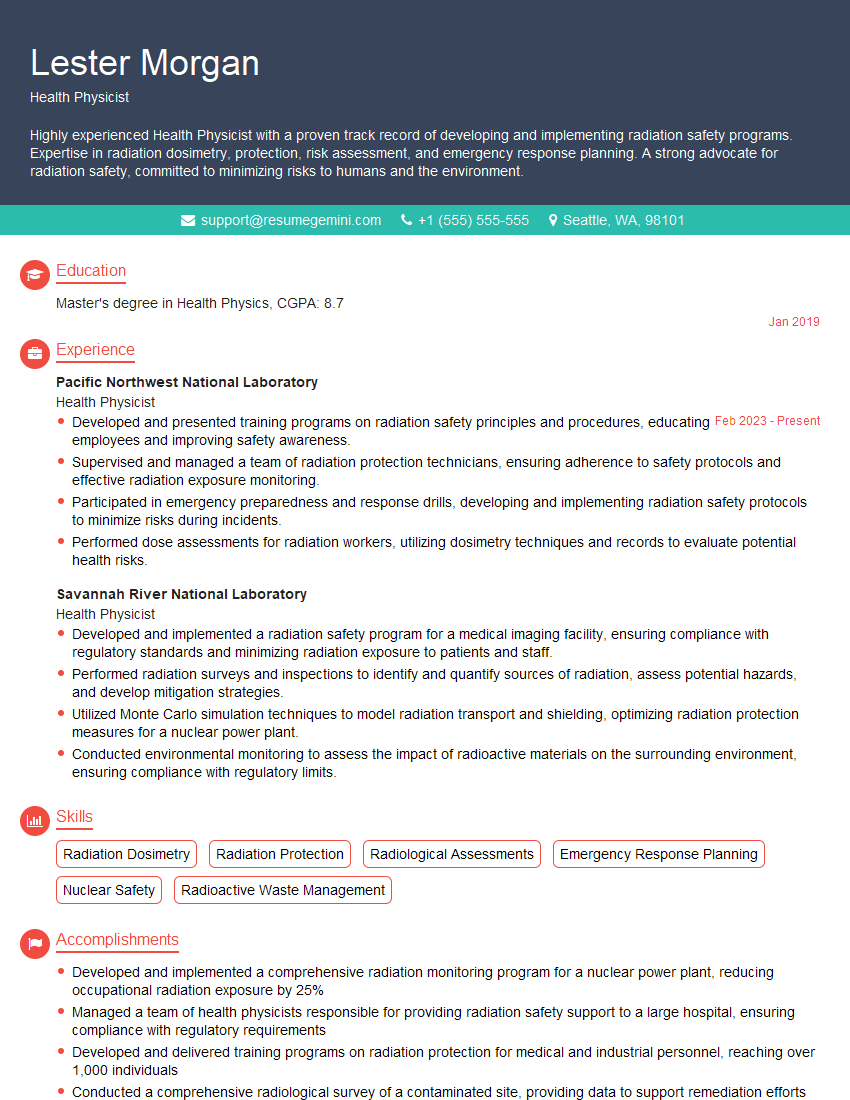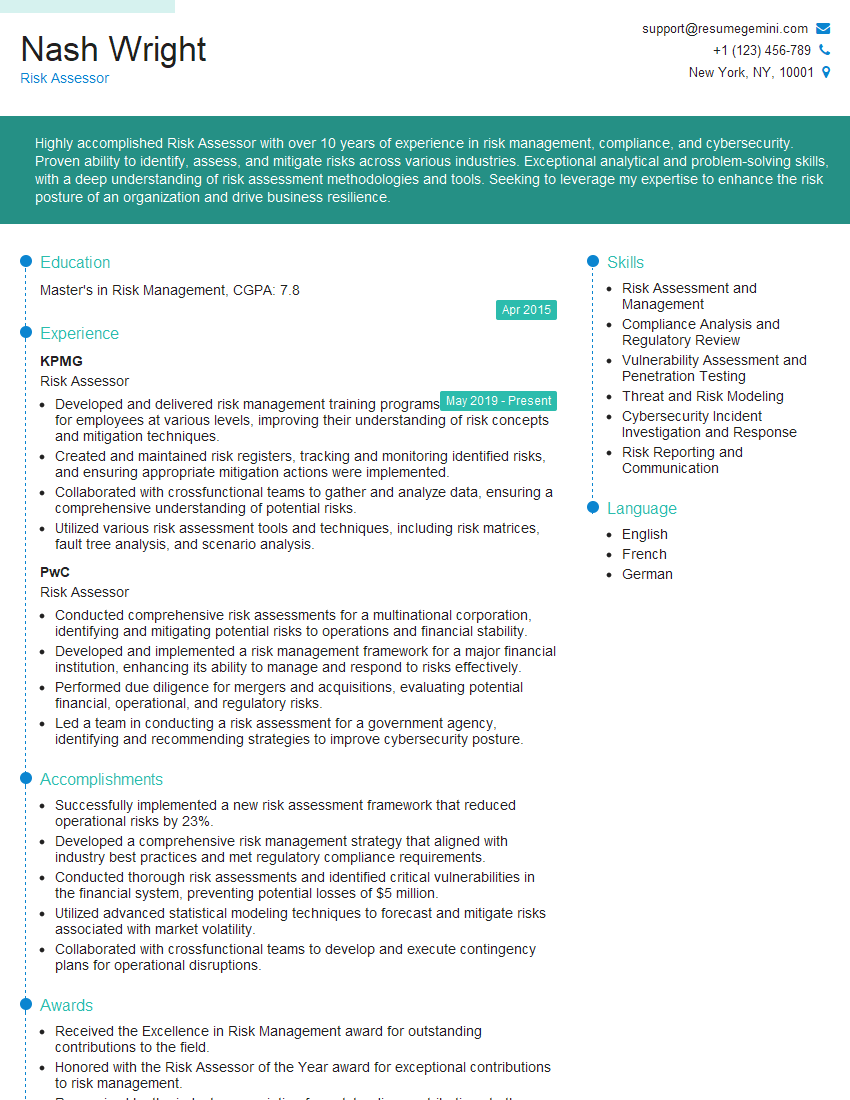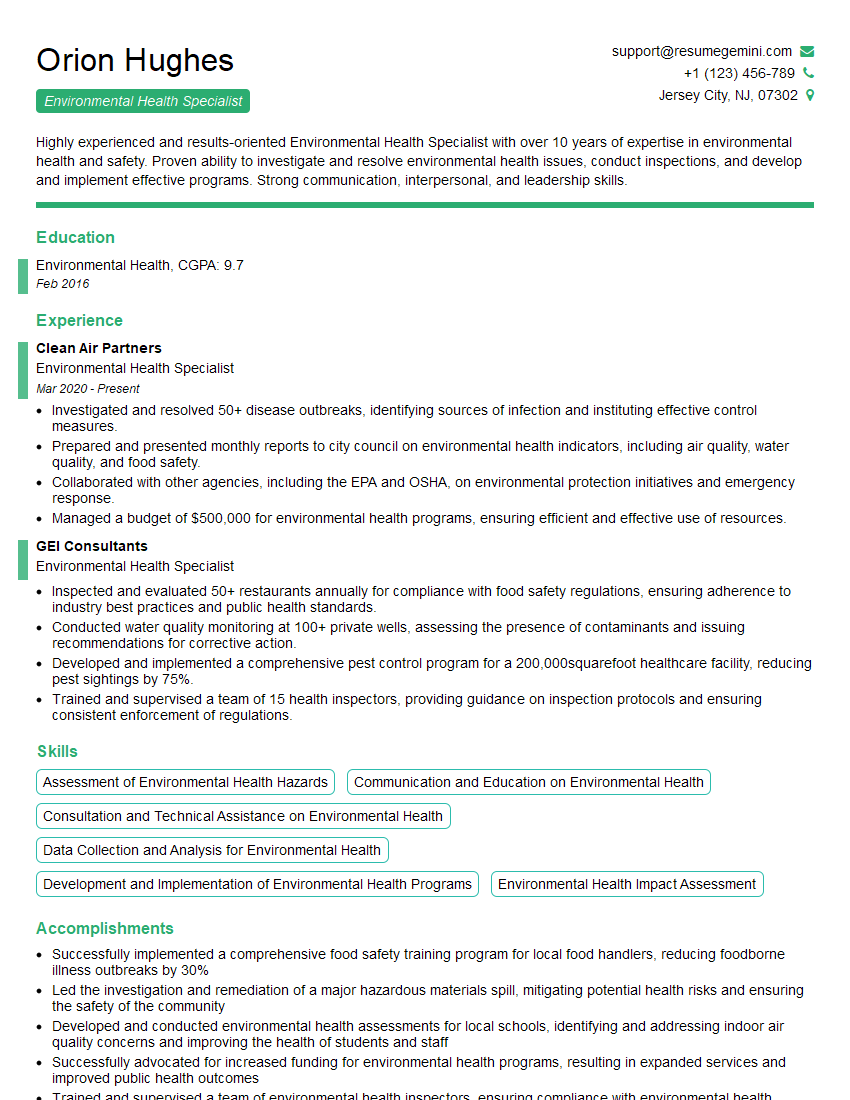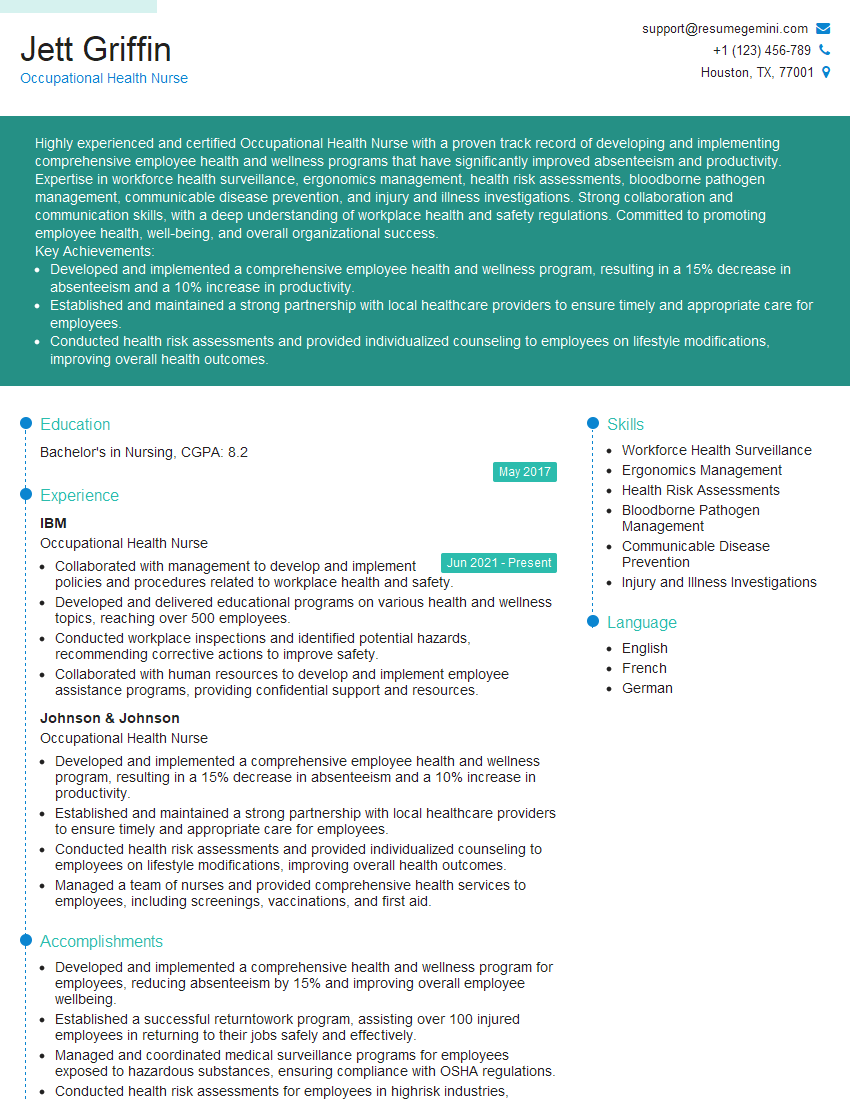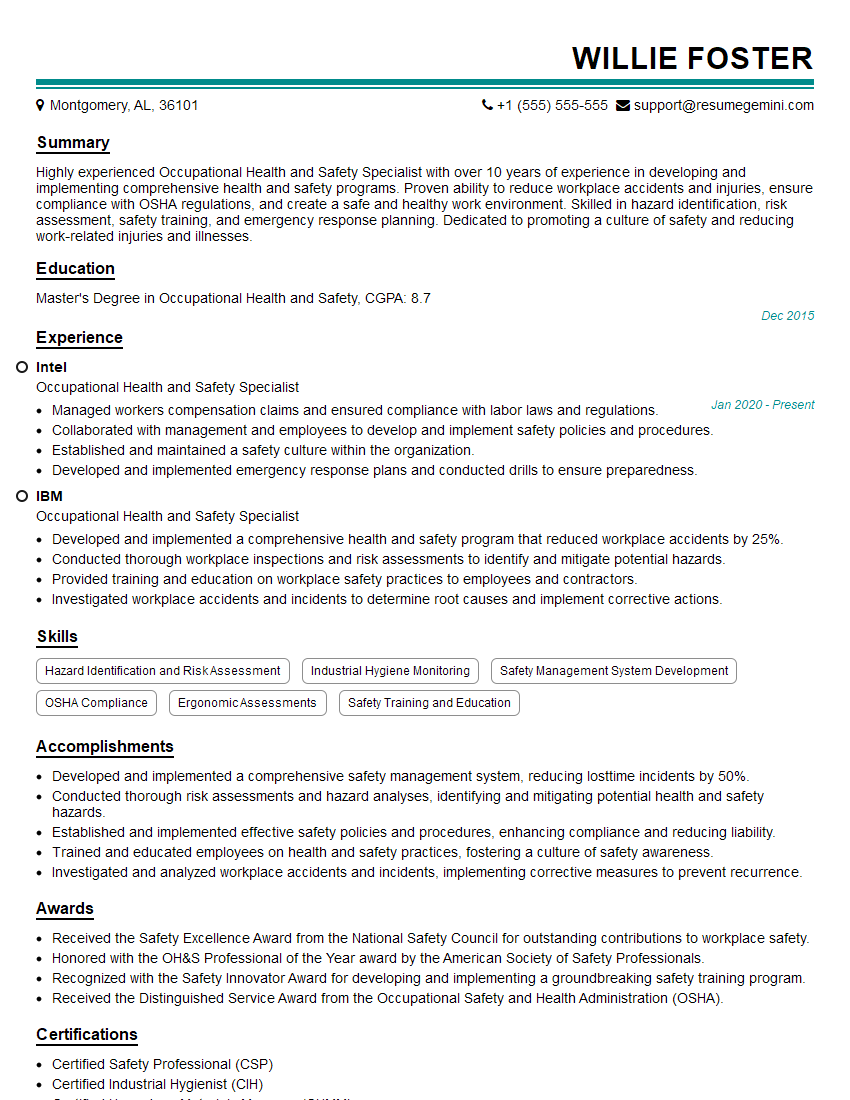The right preparation can turn an interview into an opportunity to showcase your expertise. This guide to Environmental Health Science interview questions is your ultimate resource, providing key insights and tips to help you ace your responses and stand out as a top candidate.
Questions Asked in Environmental Health Science Interview
Q 1. Explain the difference between environmental risk assessment and environmental risk management.
Environmental risk assessment (ERA) and environmental risk management (ERM) are closely related but distinct processes. ERA is the scientific process of identifying hazards, characterizing their potential to cause harm, and estimating the likelihood of that harm occurring. Think of it as figuring out what the risks are and how big they are. ERM, on the other hand, is the practical application of ERA findings to develop and implement strategies to control or mitigate those risks. It’s about deciding what to do about the risks identified.
For example, an ERA might determine that a chemical plant’s discharge contains a pollutant that could harm aquatic life. ERM would then involve developing and implementing measures like installing wastewater treatment systems, setting discharge limits, and monitoring the water quality to minimize the environmental impact.
Q 2. Describe the process of conducting a hazard identification and risk assessment for a workplace.
Hazard identification and risk assessment in a workplace involves a systematic approach to identify potential hazards and evaluate their risks. It typically follows these steps:
- Hazard Identification: This involves systematically surveying the workplace to identify potential hazards. This can include walking through the facility, reviewing safety data sheets (SDS), interviewing workers, and analyzing historical incident reports. For example, this might reveal the presence of hazardous chemicals, noisy machinery, or ergonomic issues.
- Hazard Characterization: This step involves understanding the nature of the identified hazards – their toxicity, flammability, or other harmful properties. It often relies on information from SDS, toxicological studies, and other scientific literature.
- Exposure Assessment: This determines the extent to which workers are exposed to the identified hazards. This includes determining the frequency, duration, and intensity of exposure. Methods include direct measurements (e.g., air sampling), worker questionnaires, and job task analysis.
- Risk Evaluation: This combines the hazard characterization and exposure assessment to determine the overall risk level. This often involves a qualitative (high, medium, low) or quantitative (numerical probability) assessment. This might involve calculating the risk as the product of the likelihood of exposure and the severity of the potential harm.
- Risk Control: Based on the risk evaluation, appropriate control measures are implemented to mitigate the risk. These measures can range from engineering controls (e.g., ventilation systems), administrative controls (e.g., work practices), and personal protective equipment (PPE).
Q 3. What are the key components of a comprehensive environmental health program?
A comprehensive environmental health program incorporates several key components:
- Environmental Monitoring: Regular monitoring of air, water, and soil quality to identify potential pollution sources and assess their impact. This involves systematic sampling and analysis.
- Waste Management: A robust system for managing hazardous and non-hazardous waste, including proper disposal, recycling, and reduction strategies. This often involves complying with local, state, and federal regulations.
- Emergency Preparedness and Response: Plans and procedures to address environmental emergencies, such as chemical spills or natural disasters. This includes training, drills, and effective communication protocols.
- Occupational Health and Safety: Protecting the health and safety of workers from environmental hazards within the workplace. This involves hazard identification and risk assessment, along with implementing control measures.
- Compliance and Reporting: Ensuring adherence to relevant environmental regulations and reporting requirements. This can involve maintaining accurate records and submitting regular reports to regulatory agencies.
- Community Engagement: Involving the community in environmental decision-making and ensuring transparency. This can include public forums, stakeholder consultations, and environmental education programs.
Q 4. How do you determine the appropriate sampling methods for air, water, and soil contaminants?
Selecting appropriate sampling methods depends heavily on the specific contaminant, the matrix (air, water, or soil), and the objectives of the study.
- Air Contaminants: Sampling methods for air contaminants can range from passive samplers (e.g., diffusion tubes) for long-term monitoring of low-concentration pollutants to active samplers (e.g., high-volume samplers) for short-term monitoring of higher concentrations. The choice depends on the specific pollutant and its volatility.
- Water Contaminants: Water sampling requires careful consideration of the location, depth, and time of sampling. Grab samples provide a snapshot of water quality at a specific point in time, while composite samples combine multiple samples over a period to provide an average concentration. Specific analytical methods are chosen based on the suspected contaminants.
- Soil Contaminants: Soil sampling designs usually involve collecting samples at various depths and locations across the site. The choice of sampling method (e.g., auger, core, or hand-dug) depends on the nature of the soil and the depth of contamination. The samples are then analyzed using appropriate laboratory techniques.
In all cases, proper chain of custody procedures are crucial to ensure data integrity and legal defensibility.
Q 5. Explain the principles of exposure assessment in environmental health.
Exposure assessment is a critical component of environmental health risk assessment. It aims to quantify the extent of human contact with environmental contaminants. This involves several steps:
- Identifying the Exposure Pathways: Determining how people come into contact with contaminants. This could include inhalation, ingestion, dermal contact, or other routes.
- Characterizing the Exposure Sources: Identifying the sources of contamination (e.g., industrial emissions, contaminated soil). This often involves analyzing environmental monitoring data.
- Quantifying Exposure: Measuring or estimating the magnitude, frequency, and duration of exposure. This may involve using direct measurements (e.g., personal air samplers), modeling techniques, or using data from existing databases.
- Estimating the Population Exposed: Determining the number and characteristics of people who are exposed to the contaminant. This might involve using demographic data and geographic information systems (GIS).
For example, an exposure assessment for lead contamination might involve measuring lead levels in soil, assessing children’s proximity to contaminated sites, and estimating their hand-to-mouth behavior to determine their ingestion dose.
Q 6. Describe your experience with various environmental regulations (e.g., Clean Air Act, Clean Water Act).
Throughout my career, I’ve worked extensively with various environmental regulations, including the Clean Air Act (CAA) and the Clean Water Act (CWA). My experience with the CAA involves assessing air quality data, conducting emission inventories, and evaluating compliance with National Ambient Air Quality Standards (NAAQS). I’ve helped companies develop and implement strategies to reduce air pollutants, focusing on emission control technologies and compliance monitoring.
With the CWA, my work has encompassed water quality monitoring, discharge permit applications, and compliance assessments. I’ve assisted in the development of wastewater treatment plans and helped organizations manage their stormwater runoff to meet the discharge limits set by the CWA. My experience also includes working with other relevant regulations, such as the Resource Conservation and Recovery Act (RCRA) for waste management and the Comprehensive Environmental Response, Compensation, and Liability Act (CERCLA) concerning site remediation.
Q 7. How do you interpret and apply environmental data to inform decision-making?
Interpreting and applying environmental data is central to effective environmental health decision-making. This involves several key steps:
- Data Quality Assessment: Evaluating the reliability and validity of the data. This includes assessing the sampling methods, analytical techniques, and data completeness.
- Data Analysis and Interpretation: Using appropriate statistical and modeling techniques to analyze the data and draw meaningful conclusions. This may involve trend analysis, correlation studies, and risk assessments.
- Decision-Making Framework: Using the analyzed data within a structured framework to support informed decisions. This often involves weighing the costs and benefits of different actions, considering uncertainties, and incorporating stakeholder values.
- Communication of Findings: Clearly communicating the findings and their implications to stakeholders, including decision-makers, the public, and other relevant parties. This can involve preparing reports, presentations, and visualizations.
For instance, when analyzing data on pesticide residues in agricultural products, I would consider the concentration levels, the potential health effects, and the available mitigation strategies to recommend appropriate regulations or guidelines.
Q 8. What are the different types of environmental pollution and their health impacts?
Environmental pollution encompasses various forms of contamination impacting air, water, and land. These pollutants negatively affect human health in diverse ways.
- Air Pollution: Sources include vehicle emissions, industrial processes, and wildfires. Health impacts range from respiratory illnesses like asthma and bronchitis to cardiovascular diseases and even lung cancer. For instance, prolonged exposure to particulate matter (PM2.5) is strongly linked to increased mortality rates.
- Water Pollution: Contamination from industrial discharge, agricultural runoff (containing pesticides and fertilizers), and sewage introduces pathogens, heavy metals, and toxins into water sources. Consequences include waterborne diseases, developmental problems, and organ damage. Think of the devastating effects of lead contamination in drinking water, leading to neurological issues, especially in children.
- Soil Pollution: Industrial waste, improper disposal of hazardous materials, and agricultural practices contaminate soil. This can lead to direct exposure through contact or indirectly via the food chain, resulting in various health problems, from skin irritation to cancer depending on the pollutant.
- Noise Pollution: Excessive noise from traffic, construction, and industries can cause hearing loss, stress, sleep disturbances, and cardiovascular problems. Imagine living near a constantly busy highway – the constant noise can significantly impact your well-being.
- Light Pollution: Excessive artificial light at night disrupts natural sleep-wake cycles, affecting hormone production and increasing the risk of certain cancers. It also impacts wildlife and ecosystems.
Understanding the specific pollutants and their pathways of exposure is crucial for effective prevention and mitigation strategies.
Q 9. Explain your understanding of the precautionary principle in environmental health.
The precautionary principle, in the context of environmental health, advocates for preventative action even in the absence of complete scientific certainty about the potential harm of a substance or activity. It emphasizes taking proactive measures to protect human health and the environment when there’s a reasonable suspicion of risk, rather than waiting for definitive proof of harm.
This principle is particularly important when dealing with emerging contaminants or situations with potential irreversible damage. For example, if a new chemical is suspected of causing harm, the precautionary principle would suggest restricting its use until its safety is confirmed through thorough research. This approach prioritizes prevention over cure and emphasizes responsible environmental stewardship.
Q 10. How do you communicate complex environmental health information to diverse audiences?
Communicating complex environmental health information effectively requires tailoring the message to the specific audience. I utilize several strategies:
- Simplify Language: Avoiding technical jargon and using plain language makes the information accessible to everyone.
- Visual Aids: Charts, graphs, and infographics help visualize data and complex relationships, making information more engaging and understandable.
- Storytelling: Using real-life examples and narratives makes the information relatable and memorable.
- Interactive Sessions: Q&A sessions, workshops, and hands-on activities foster engagement and allow for clarification.
- Targeted Messaging: Framing the message to resonate with specific audiences (e.g., children, policymakers, community groups) enhances impact.
- Multi-Platform Approach: Using a variety of channels such as websites, social media, and community outreach programs ensures broad reach.
For instance, when communicating about climate change to children, I might use engaging animations and interactive games. When addressing policymakers, I would focus on the economic and societal impacts.
Q 11. Describe your experience with environmental monitoring and data analysis techniques.
My experience includes various environmental monitoring and data analysis techniques. I’m proficient in:
- Sampling and Field Measurements: Collecting air, water, and soil samples, using appropriate equipment and adhering to rigorous quality control procedures.
- Laboratory Analysis: Performing or overseeing laboratory analyses of samples, including chemical analysis, microbiological testing, and toxicity assessments.
- Statistical Analysis: Utilizing statistical software (e.g., R, SPSS) to analyze environmental data, identifying trends, and assessing significance.
- GIS (Geographic Information Systems): Using GIS software to map environmental data, visualize spatial patterns, and model pollutant dispersal.
- Data Management and Reporting: Organizing, managing, and reporting environmental data in a clear and concise manner, adhering to relevant standards and regulations.
For example, in a past project, I used GIS to map the spatial distribution of heavy metals in a contaminated site, guiding remediation efforts. I also utilized statistical modeling to predict the future levels of air pollutants based on different emission scenarios.
Q 12. How do you handle conflicting environmental priorities or regulations?
Conflicting environmental priorities and regulations are common challenges. My approach involves:
- Stakeholder Engagement: Facilitating discussions and collaboration among all stakeholders (government agencies, industry, community groups) to find mutually agreeable solutions.
- Cost-Benefit Analysis: Evaluating the economic, social, and environmental impacts of different options to identify the most effective and equitable solution.
- Prioritization: Based on risk assessment and available resources, prioritizing actions to address the most pressing environmental issues.
- Adaptive Management: Regularly monitoring and evaluating the effectiveness of implemented strategies and adjusting them as needed based on new information or changing circumstances.
- Legal and Regulatory Compliance: Ensuring that all actions comply with existing laws and regulations while working towards improvements.
For instance, balancing the need for economic development with environmental protection requires careful consideration of trade-offs and finding innovative solutions that minimize negative impacts.
Q 13. What are your strategies for ensuring compliance with environmental regulations?
Ensuring compliance with environmental regulations requires a multi-faceted approach:
- Regular Monitoring and Audits: Conducting routine environmental monitoring and internal audits to identify potential compliance gaps.
- Training and Education: Providing comprehensive training to staff on environmental regulations and best practices.
- Record Keeping: Maintaining detailed and accurate records of all environmental activities and compliance efforts.
- Reporting and Documentation: Submitting accurate and timely reports to regulatory agencies.
- Continuous Improvement: Implementing a system for continuous improvement to enhance environmental performance and compliance.
- Proactive Engagement with Regulatory Agencies: Maintaining open communication with regulatory agencies to address any potential issues promptly.
This proactive approach minimizes the risk of penalties and ensures the organization’s commitment to environmental responsibility.
Q 14. Explain your experience with environmental impact assessments.
My experience encompasses all phases of environmental impact assessments (EIAs):
- Scoping: Identifying potential environmental impacts of a proposed project.
- Baseline Data Collection: Gathering data on existing environmental conditions.
- Impact Prediction: Using models and expert judgment to predict the potential impacts of the project.
- Mitigation Measures: Developing strategies to avoid, minimize, or compensate for negative impacts.
- Impact Assessment Reporting: Preparing a comprehensive report detailing the findings of the EIA.
- Public Consultation: Engaging with stakeholders and the public to obtain feedback on the project and its potential impacts.
A recent project involved conducting an EIA for a new highway construction. This included assessing impacts on air and water quality, noise levels, and biodiversity, developing mitigation plans, and engaging with local communities.
Q 15. What are the ethical considerations involved in environmental health research and practice?
Ethical considerations in environmental health research and practice are paramount, ensuring fairness, transparency, and respect for all stakeholders. These considerations encompass several key areas.
- Informed Consent: Participants in research studies must fully understand the study’s purpose, procedures, potential risks and benefits, and their right to withdraw at any time. This is particularly crucial in vulnerable populations who may be disproportionately affected by environmental hazards.
- Justice and Equity: Research and interventions should address environmental injustices, ensuring that marginalized communities are not disproportionately burdened by environmental hazards. This requires careful consideration of factors like race, socioeconomic status, and geographic location.
- Data Privacy and Confidentiality: Protecting the privacy and confidentiality of individuals involved in research is crucial. Data should be anonymized or de-identified whenever possible, and appropriate security measures should be in place.
- Conflicts of Interest: Researchers and practitioners must be transparent about any potential conflicts of interest, such as funding from industries with vested interests in environmental outcomes. This ensures objectivity and integrity in the research and practice.
- Community Engagement: Engaging with affected communities throughout the research process is vital. This includes informing communities about research findings, actively seeking their input, and ensuring that research benefits them directly.
For example, a study investigating the impact of a nearby factory on local air quality should prioritize engaging with the community, obtaining informed consent, and ensuring that any findings are shared and used to improve their health and well-being. Ignoring these ethical considerations could lead to distrust, inaccurate data, and potentially harmful consequences for vulnerable populations.
Career Expert Tips:
- Ace those interviews! Prepare effectively by reviewing the Top 50 Most Common Interview Questions on ResumeGemini.
- Navigate your job search with confidence! Explore a wide range of Career Tips on ResumeGemini. Learn about common challenges and recommendations to overcome them.
- Craft the perfect resume! Master the Art of Resume Writing with ResumeGemini’s guide. Showcase your unique qualifications and achievements effectively.
- Don’t miss out on holiday savings! Build your dream resume with ResumeGemini’s ATS optimized templates.
Q 16. Describe your familiarity with GIS and its applications in environmental health.
Geographic Information Systems (GIS) are indispensable tools in environmental health. My familiarity extends to using GIS software (like ArcGIS or QGIS) for data visualization, spatial analysis, and modeling.
Applications in environmental health include:
- Mapping disease outbreaks: GIS can visually display the spatial distribution of disease cases, helping identify clusters and potential environmental risk factors. For instance, we can map the incidence of asthma cases alongside proximity to industrial pollution sources.
- Assessing environmental hazards: GIS helps assess the spatial distribution of various environmental hazards like air and water pollution, identifying areas at high risk. This is useful in setting pollution control priorities or identifying communities in need of intervention.
- Environmental justice studies: GIS can be used to investigate whether environmental hazards are disproportionately located near vulnerable populations, providing evidence for environmental justice advocacy.
- Risk assessment and modeling: GIS integrates with various models to predict the spread of pollutants or the impact of environmental changes on human health, allowing for proactive intervention planning.
For example, I’ve used GIS to map the location of lead paint hazards in older housing units, overlaid with demographic data to identify areas with high concentrations of children at risk of lead poisoning. This helped target lead abatement efforts effectively.
Q 17. What are some common environmental health hazards in industrial settings?
Industrial settings present a wide array of environmental health hazards. These hazards can be broadly categorized into:
- Chemical hazards: Exposure to toxic chemicals like solvents, heavy metals, asbestos, and pesticides can cause acute or chronic health effects, including cancer, respiratory illnesses, and neurological damage. Proper ventilation and personal protective equipment (PPE) are crucial.
- Physical hazards: Noise pollution, extreme temperatures, vibration, and radiation can lead to hearing loss, heatstroke, musculoskeletal disorders, and various cancers. Noise reduction measures, temperature control, and safety protocols are necessary.
- Biological hazards: Exposure to bacteria, viruses, fungi, and other biological agents can cause various infectious diseases. Strict sanitation practices and appropriate waste disposal are vital.
- Ergonomic hazards: Poor workplace design and repetitive movements can cause musculoskeletal injuries. Ergonomic assessments and adjustments to workstations are needed.
- Psychosocial hazards: Stress, violence, and harassment can affect mental health and overall well-being. Creating a safe and supportive work environment is essential.
For instance, a steel mill might have high levels of noise and airborne particulate matter, while a chemical plant could expose workers to toxic solvents. Effective industrial hygiene practices, including monitoring and control of exposures, are critical to mitigate these risks.
Q 18. Explain the role of epidemiology in investigating environmental health issues.
Epidemiology plays a crucial role in investigating environmental health issues by studying the distribution and determinants of disease and health-related events in populations. It helps establish links between environmental exposures and health outcomes.
Epidemiological studies employ various designs, including:
- Descriptive studies: These describe the occurrence of a disease in terms of person, place, and time. For example, mapping the incidence of a respiratory disease near a factory.
- Analytical studies: These investigate the causes of disease, often comparing exposed and unexposed groups. For example, a cohort study comparing lung cancer rates in workers exposed to asbestos versus unexposed workers.
- Ecological studies: These assess the relationship between environmental exposures and health outcomes at the population level. For example, comparing cancer rates in different regions with varying levels of air pollution.
Epidemiological investigations often involve data collection (e.g., surveys, medical records, environmental monitoring), statistical analysis to determine associations, and the development of risk assessments. The findings inform public health interventions and policies aimed at preventing or reducing environmentally related diseases.
Q 19. Describe your experience with environmental modeling and simulation.
My experience with environmental modeling and simulation includes using various software and techniques to predict the fate and transport of pollutants in the environment and their potential health impacts.
I have utilized:
- Air dispersion models (e.g., AERMOD, CALPUFF): To predict the concentration of air pollutants at different locations downwind from emission sources. This involves inputting emission data, meteorological information, and terrain data to simulate pollutant dispersion.
- Water quality models (e.g., QUAL2K): To simulate the transport and fate of pollutants in rivers and streams. This helps assess the impact of pollution sources on water quality and potential risks to human health from drinking water or recreational exposure.
- Exposure assessment models: To estimate the dose of pollutants received by individuals or populations. This is done by integrating environmental concentration data with information about exposure pathways (e.g., inhalation, ingestion, dermal contact).
For example, I’ve used air dispersion modeling to assess the potential impact of a proposed industrial plant on local air quality and human health, which influenced the plant’s design and mitigation measures.
Example code snippet (conceptual)://Simplified example of calculating air pollutant concentrationconcentration = emission_rate / (wind_speed * dispersion_coefficient);
Q 20. What are your strategies for addressing environmental injustice?
Addressing environmental injustice requires a multi-pronged approach focusing on identifying disparities, advocating for policy changes, and promoting community engagement.
- Identify and quantify environmental disparities: Use GIS and other tools to map the spatial distribution of environmental hazards and assess whether certain communities are disproportionately affected. This data provides evidence of environmental injustice.
- Advocate for policy changes: Work with policymakers and regulatory agencies to promote policies that ensure environmental protection for all communities, regardless of race, socioeconomic status, or geographic location. This might include stricter environmental regulations, funding for remediation projects in affected areas, and community involvement in decision-making.
- Promote community engagement: Work closely with affected communities to empower them to participate in environmental decision-making processes. This involves providing education and resources, actively listening to community concerns, and collaborating on solutions.
- Support community-based initiatives: Help communities develop and implement their own solutions to environmental problems. This could include community gardens, clean-up initiatives, and advocacy campaigns.
For example, working with a community facing disproportionate exposure to air pollution from a nearby highway might involve advocating for noise barriers, improved public transportation, and community health education programs.
Q 21. How do you stay current with advances in environmental health science and technology?
Staying current in environmental health science and technology requires a proactive and multifaceted approach.
- Peer-reviewed journals and publications: Regularly reading journals like Environmental Health Perspectives, Environmental Science & Technology, and others provides insights into the latest research and discoveries.
- Professional conferences and workshops: Attending conferences and workshops allows for networking, learning about cutting-edge research, and gaining new perspectives.
- Online resources and databases: Utilizing online resources like PubMed, Google Scholar, and government agency websites provides access to a wealth of information.
- Continuing education courses and training programs: Participating in professional development activities keeps skills and knowledge updated.
- Networking with colleagues and experts: Engaging with peers and professionals in the field through professional organizations and online platforms facilitates information sharing and collaboration.
For example, I regularly subscribe to several environmental health journals, attend the annual meeting of the Society for Environmental Toxicology and Chemistry (SETAC), and participate in online forums to stay updated on the latest advancements in environmental monitoring technologies and risk assessment methodologies.
Q 22. Explain your understanding of different remediation techniques for contaminated sites.
Remediation techniques for contaminated sites aim to reduce or eliminate environmental hazards. The choice of technique depends heavily on the type and extent of contamination, the site’s characteristics (soil type, groundwater flow), and regulatory requirements. Common methods fall into several categories:
- In-situ remediation: Treatment occurs on-site, minimizing the need to excavate and transport contaminated materials. Examples include:
- Bioremediation: Using microorganisms to break down contaminants. This is cost-effective and environmentally friendly but can be slow and requires specific conditions.
- Pump and Treat: Extracting groundwater, treating it to remove contaminants, and then returning it to the aquifer. Effective for dissolved contaminants, but can be expensive and time-consuming.
- Soil Vapor Extraction (SVE): Removing volatile organic compounds from the soil by applying vacuum pressure. Suitable for volatile contaminants in permeable soils.
- Ex-situ remediation: Contaminated materials are removed from the site and treated elsewhere. Examples include:
- Excavation and disposal: Digging up contaminated soil and disposing of it in a hazardous waste landfill. This is effective but can be expensive and disruptive.
- Soil washing: Separating contaminants from soil using water and other washing agents. Effective for certain contaminants but generates wastewater that needs treatment.
- Thermal desorption: Heating contaminated soil to vaporize and remove contaminants. Effective for volatile and semi-volatile organic compounds.
For instance, a site contaminated with petroleum hydrocarbons might benefit from bioremediation or SVE, while a site with heavy metals might require excavation and disposal or soil washing. The selection process involves a detailed site assessment, risk assessment, and feasibility study to determine the most appropriate and effective approach.
Q 23. What are the key considerations for designing a sustainable environmental health program?
Designing a sustainable environmental health program requires a holistic approach encompassing ecological, social, and economic considerations. Key aspects include:
- Pollution Prevention: Focusing on reducing waste and emissions at the source, rather than solely managing pollution after it’s been generated. This involves implementing cleaner production methods and promoting sustainable consumption patterns.
- Community Engagement: Involving local communities in the planning and implementation phases is crucial. Their input ensures the program is relevant, addresses their concerns, and enjoys greater acceptance.
- Environmental Justice: Ensuring that environmental risks and benefits are distributed equitably across all communities, avoiding disproportionate impacts on vulnerable populations.
- Resource Management: Implementing strategies for efficient use of water, energy, and other resources. This includes promoting renewable energy sources and water conservation.
- Monitoring and Evaluation: Regularly tracking the program’s effectiveness through data collection and analysis. This allows for timely adjustments and ensures the program achieves its goals.
- Policy Integration: Aligning the program with relevant environmental policies and regulations, ensuring compliance and leveraging policy incentives.
For example, a sustainable program might integrate green infrastructure (like rain gardens) to manage stormwater runoff, promote local food systems to reduce transportation emissions, and provide environmental education programs to raise community awareness.
Q 24. Describe your experience working with stakeholders in environmental health projects.
My experience working with stakeholders in environmental health projects emphasizes building trust and fostering collaborative relationships. This involves:
- Effective Communication: Clearly communicating complex technical information to diverse audiences, using plain language and visual aids.
- Active Listening: Paying close attention to stakeholders’ concerns and perspectives, demonstrating empathy and understanding.
- Conflict Resolution: Addressing disagreements constructively, finding common ground, and seeking mutually agreeable solutions.
- Transparency and Accountability: Maintaining open communication, providing regular updates, and being accountable for project decisions.
- Relationship Building: Investing time in building strong relationships with stakeholders through regular meetings, site visits, and community events.
In one project involving a contaminated site cleanup, I worked closely with residents, local businesses, and regulatory agencies to develop a remediation plan that addressed everyone’s concerns. This involved multiple meetings, public forums, and ongoing dialogue to ensure transparency and build consensus. The result was a successful remediation project that minimized disruption to the community and achieved environmental goals.
Q 25. How do you approach the problem of emerging environmental contaminants?
Emerging environmental contaminants pose unique challenges due to their novel nature and often unknown long-term effects. My approach involves a multi-pronged strategy:
- Surveillance and Monitoring: Implementing robust monitoring programs to detect the presence and levels of these contaminants in environmental media (air, water, soil). This includes developing new analytical methods to detect these substances.
- Research and Risk Assessment: Conducting research to understand the toxicity, fate, and transport of emerging contaminants. This involves assessing potential risks to human health and the environment.
- Regulatory Development: Working with regulatory agencies to develop appropriate standards and regulations for these contaminants. This is crucial to ensure effective risk management.
- Pollution Prevention: Promoting the use of safer alternatives and implementing pollution prevention strategies to minimize the release of emerging contaminants into the environment.
- Communication and Education: Raising public awareness about the risks of emerging contaminants and promoting responsible behavior to reduce exposure.
For example, the emergence of per- and polyfluoroalkyl substances (PFAS) has prompted extensive research into their toxicity and environmental fate, leading to new monitoring protocols and regulatory actions.
Q 26. Explain your understanding of life cycle assessment (LCA) and its applications.
Life Cycle Assessment (LCA) is a comprehensive methodology for evaluating the environmental impacts of a product, process, or service throughout its entire life cycle, from raw material extraction to disposal or recycling. It considers various environmental impacts, including greenhouse gas emissions, water consumption, energy use, and waste generation. LCAs typically involve four stages:
- Goal and Scope Definition: Clearly defining the objectives of the LCA and the system boundaries.
- Inventory Analysis: Quantifying the inputs and outputs of the system, including materials, energy, and emissions.
- Impact Assessment: Evaluating the environmental impacts associated with the inventory data, often using specific impact categories like climate change or eutrophication.
- Interpretation: Analyzing the results of the impact assessment and drawing conclusions about the environmental performance of the system.
LCAs are used in various applications, including product design, comparing alternative technologies, informing policy decisions, and promoting sustainability initiatives. For example, an LCA might be used to compare the environmental impacts of different packaging materials, leading to a more environmentally friendly choice.
Q 27. What are the different types of environmental permits and their requirements?
The specific types of environmental permits and their requirements vary depending on the jurisdiction and the nature of the activity. However, some common permit types include:
- Air Quality Permits: Required for facilities that emit pollutants into the air, specifying emission limits and monitoring requirements.
- Water Discharge Permits: Required for facilities that discharge wastewater or stormwater into surface waters or groundwater, specifying effluent limits and monitoring protocols.
- Hazardous Waste Permits: Required for facilities that generate, store, treat, transport, or dispose of hazardous waste, specifying handling and disposal methods.
- Solid Waste Permits: Required for facilities that manage solid waste, including landfills, incinerators, and recycling facilities.
- Stormwater Permits: Required for industrial and construction sites to manage stormwater runoff and prevent pollution.
- Spill Prevention, Control, and Countermeasures (SPCC) Plans: Required for facilities that store significant quantities of oil or other hazardous substances to prevent spills and mitigate their impacts.
Each permit has specific requirements, including detailed applications, environmental assessments, monitoring plans, and compliance reports. Non-compliance can result in penalties, including fines and legal action.
Q 28. Describe your experience in investigating and resolving environmental health complaints.
Investigating and resolving environmental health complaints involves a systematic approach:
- Initial Assessment: Gathering information about the complaint, including the nature of the problem, location, and potential sources. This may involve phone calls, site visits, and review of existing data.
- Site Investigation: Conducting a thorough on-site investigation to assess the environmental conditions and identify potential causes of the complaint. This could involve sampling air, water, or soil, and conducting noise level measurements.
- Data Analysis and Interpretation: Analyzing collected data to identify potential sources of the problem and assessing the risk to human health and the environment.
- Enforcement and Remediation: If a violation is identified, enforcement actions may be taken, which could include issuing warnings, issuing fines, and requiring remediation to address the problem.
- Follow-up: Monitoring the situation after remediation to ensure the problem has been resolved and prevent future occurrences.
I once investigated a complaint about foul odors emanating from an industrial facility. This involved multiple site visits, air sampling, and discussions with the facility’s management. The investigation revealed a malfunctioning ventilation system, resulting in the release of odorous gases. Working with the facility, we implemented corrective measures, monitored air quality, and verified the resolution of the complaint.
Key Topics to Learn for Your Environmental Health Science Interview
Acing your interview requires a strong grasp of core Environmental Health Science principles. Focus your preparation on understanding both the theoretical underpinnings and practical applications of these key areas:
- Environmental Toxicology: Understanding the harmful effects of environmental pollutants on human health, including exposure pathways and risk assessment methodologies. Consider practical applications in risk management and public health interventions.
- Environmental Microbiology: Knowledge of microbial agents in the environment, their transmission pathways, and their impact on human health. This includes understanding waterborne and foodborne illnesses, and strategies for prevention and control.
- Occupational Health and Safety: Familiarity with workplace hazards and the implementation of safety protocols to protect workers’ health. Focus on practical risk assessment, hazard identification, and control measures.
- Air and Water Quality Management: Understanding the principles of air and water pollution control, including monitoring techniques, regulatory frameworks, and remediation strategies. Think about case studies demonstrating your problem-solving abilities.
- Environmental Epidemiology: Knowledge of the methods used to study the relationship between environmental factors and health outcomes. Consider the design and interpretation of epidemiological studies, and their role in informing public health policy.
- Environmental Policy and Legislation: A general understanding of key environmental regulations and policies relevant to your field. Be prepared to discuss current environmental challenges and potential solutions.
- Sustainability and Environmental Management: Explore the concepts of sustainable development and environmental management practices. Be ready to discuss your commitment to environmentally responsible practices.
Next Steps: Launch Your Environmental Health Science Career
Mastering these key areas will significantly boost your interview performance and demonstrate your readiness for a rewarding career in Environmental Health Science. To maximize your job prospects, crafting a compelling and ATS-friendly resume is crucial. An effective resume highlights your skills and experience in a way that Applicant Tracking Systems (ATS) can easily recognize, ensuring your application gets seen.
We highly recommend using ResumeGemini to build a professional and impactful resume. ResumeGemini provides a user-friendly platform and offers examples of resumes tailored to Environmental Health Science, helping you present your qualifications effectively. Take the next step towards your dream career today!
Explore more articles
Users Rating of Our Blogs
Share Your Experience
We value your feedback! Please rate our content and share your thoughts (optional).
What Readers Say About Our Blog
This was kind of a unique content I found around the specialized skills. Very helpful questions and good detailed answers.
Very Helpful blog, thank you Interviewgemini team.

